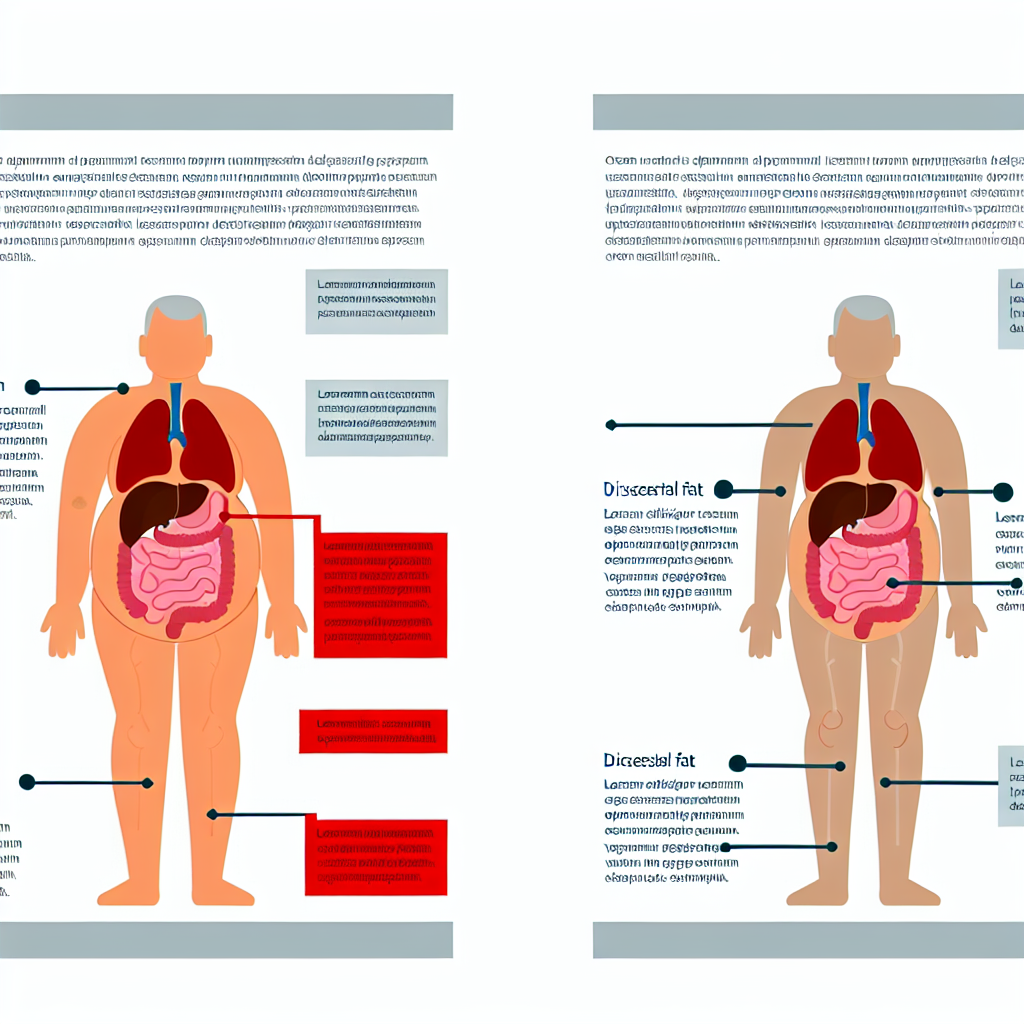Visceral Fat: Health Risks and How to Reduce It
Visceral fat—the dangerous belly fat surrounding your organs—increases disease risk dramatically. Learn 7 evidence-based strategies to reduce visceral adiposity and improve metabolic health.
What is Visceral Fat?
Visceral fat is metabolically active adipose tissue stored deep in the abdominal cavity, surrounding vital organs including the liver, pancreas, and intestines. Unlike subcutaneous fat (fat under the skin), visceral fat is highly inflammatory and metabolically dangerous.
Key Differences: Visceral vs Subcutaneous Fat

- • Deep in abdomen around organs
- • Highly metabolically active
- • Releases inflammatory cytokines
- • Increases disease risk dramatically
- • Lost first during weight loss
- • Under skin, pinchable
- • Relatively metabolically inert
- • Energy storage function
- • Lower health risk
- • Lost later during weight loss
Why Visceral Fat is Dangerous
- Inflammatory signaling: Releases IL-6, TNF-α, and other cytokines driving systemic inflammation
- Fatty acid release: Directly drains into portal vein, affecting liver metabolism and causing insulin resistance
- Hormone disruption: Alters adiponectin, leptin, and other metabolic hormones
- Organ compression: Physical pressure on surrounding organs impairs function
Health Risks of Visceral Fat
Visceral adiposity is independently associated with multiple chronic diseases, even in individuals with normal BMI:
Framingham Heart Study: Each 1cm increase in waist circumference = 1% higher cardiovascular risk
Meta-analysis: Visceral fat area >100 cm² associated with 4.3x diabetes risk (95% CI: 3.2-5.8)
AHA/NHLBI criteria: Waist >40" men / >35" women = primary metabolic syndrome criterion
Pooled analysis: High visceral fat linked to 20-60% higher risk for colorectal, breast, pancreatic cancers
How to Measure Visceral Fat
Various methods exist to assess visceral fat, ranging from simple home measurements to advanced imaging:
Risk Cutoffs:
High risk: Men >40" (102cm), Women >35" (88cm)
Risk Cutoffs:
High risk: Men >0.90, Women >0.85
Risk Cutoffs:
Android/gynoid ratio, visceral fat area measurements
Risk Cutoffs:
>100 cm² at L4-L5 = high risk
7 Evidence-Based Visceral Fat Reduction Strategies
These strategies target visceral fat specifically, with documented reductions from peer-reviewed research:
- 1.Create 500-750 calorie daily deficit (lose 1-1.5 lbs/week)
- 2.Visceral fat preferentially lost in early weight loss (before subcutaneous)
- 3.Track intake with food diary or app for accuracy
- 4.Focus on sustainable deficit, not extreme restriction
- 1.Target 1.6-2.2g protein per kg body weight daily
- 2.Include protein at every meal (25-40g per meal)
- 3.Lean sources: chicken, fish, eggs, Greek yogurt, legumes
- 4.Protein increases satiety and preserves muscle during weight loss
- 1.Resistance training: 3x/week, full-body, 70-80% 1RM
- 2.Cardio: 150-300 min/week moderate OR 75-150 min vigorous
- 3.Combined training superior to either alone for visceral fat
- 4.HIIT particularly effective: 3x/week, 20-30 min sessions
- 1.Extra virgin olive oil as primary fat (3-4 Tbsp daily)
- 2.Fatty fish 2-3x weekly (salmon, sardines, mackerel)
- 3.Daily vegetables (5+ servings), fruits (2-3 servings)
- 4.Whole grains, legumes, nuts; limit red meat and processed foods
- 1.Remove sugar-sweetened beverages (largest source)
- 2.Eliminate processed snacks, baked goods, candy
- 3.Replace refined grains with whole grains
- 4.Read labels: avoid high-fructose corn syrup, added sugars
- 1.Consistent 7-8 hour sleep schedule
- 2.Sleep regularity as important as duration
- 3.Address sleep disorders (sleep apnea common with visceral obesity)
- 4.Improve sleep hygiene: dark, cool room, regular timing
- 1.Daily stress reduction: meditation, yoga, breathing exercises
- 2.Regular physical activity (doubles as cortisol control)
- 3.Adequate sleep (cortisol dysregulation with poor sleep)
- 4.Social connection and support systems
Evidence-Based Supplements for Visceral Fat
These supplements have research support for reducing visceral fat when combined with diet and exercise:
Evidence:
Reduces visceral fat via anti-inflammatory effects and improved insulin sensitivity
Safety:
Excellent - consult physician if >3g/day or on blood thinners
Evidence:
Meta-analysis: 1.3kg greater visceral fat loss when combined with exercise
Safety:
Good - monitor liver function with high doses, take with food
Evidence:
Improves insulin sensitivity, reduces visceral fat through AMPK activation
Safety:
Good - may cause GI upset initially, avoid if pregnant
Supplements are adjuncts, not replacements for diet and exercise. Always consult healthcare provider before starting. Quality varies—choose third-party tested products (USP, NSF, ConsumerLab).
Frequently Asked Questions
Yes—this is called "metabolically obese normal weight" (MONW) or "skinny fat." Up to 30% of normal-BMI individuals have excess visceral fat and associated metabolic dysfunction. Waist circumference and body composition testing are more important than BMI alone.
Visceral fat responds quickly to intervention—faster than subcutaneous fat. With consistent diet and exercise, expect 25-40% reduction in visceral fat within 8-12 weeks of 5-10% body weight loss. Early weight loss preferentially targets visceral deposits.
Combined resistance training and cardio is most effective. Meta-analysis shows resistance + cardio reduces visceral fat 6.1% (SMD -0.35). HIIT (high-intensity interval training) is particularly efficient: 3x/week, 20-30 minutes shows significant visceral fat reduction.
No—spot reduction is a myth. However, visceral fat is preferentially mobilized during weight loss before subcutaneous fat. You cannot target visceral fat directly, but caloric deficit + exercise effectively reduces it first.
Genetics influence visceral fat accumulation (30-60% heritable), but lifestyle factors are dominant. Even with genetic predisposition, diet, exercise, sleep, and stress management effectively reduce visceral adiposity. Genetics load the gun, lifestyle pulls the trigger.
The Bottom Line
Visceral fat is the most metabolically dangerous adipose tissue, dramatically increasing risk of cardiovascular disease (2-3x), type 2 diabetes (3-5x), metabolic syndrome (5-6x), and cancer (20-60%). The good news: visceral fat responds rapidly to lifestyle intervention.
- Caloric deficit (500-750 cal/day) produces 25-40% visceral fat reduction with 5-10% weight loss
- Combined resistance + cardio training is most effective (6.1% reduction, SMD -0.35)
- High-protein diet (25-30% calories) enhances visceral fat loss vs standard protein
- Mediterranean diet with olive oil reduces waist circumference more than low-fat diet
- Eliminate added sugars, especially sugar-sweetened beverages (0.65 cm²/year gain per daily serving)
Visceral fat is preferentially lost in early weight loss—before subcutaneous fat. This means even modest weight reduction (5-10%) produces disproportionate metabolic benefits. Track waist circumference monthly; consider DEXA scan to quantify progress objectively.
